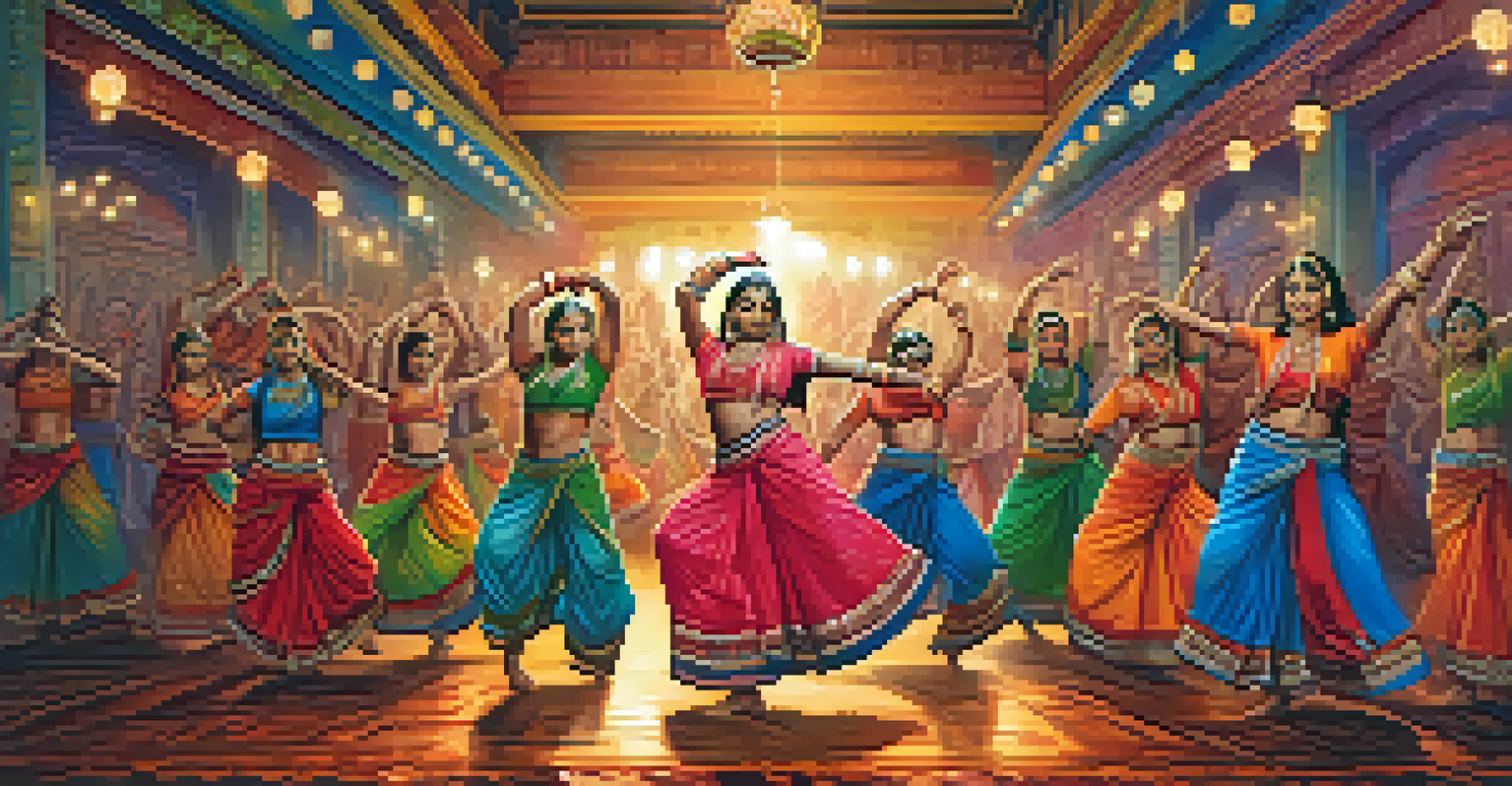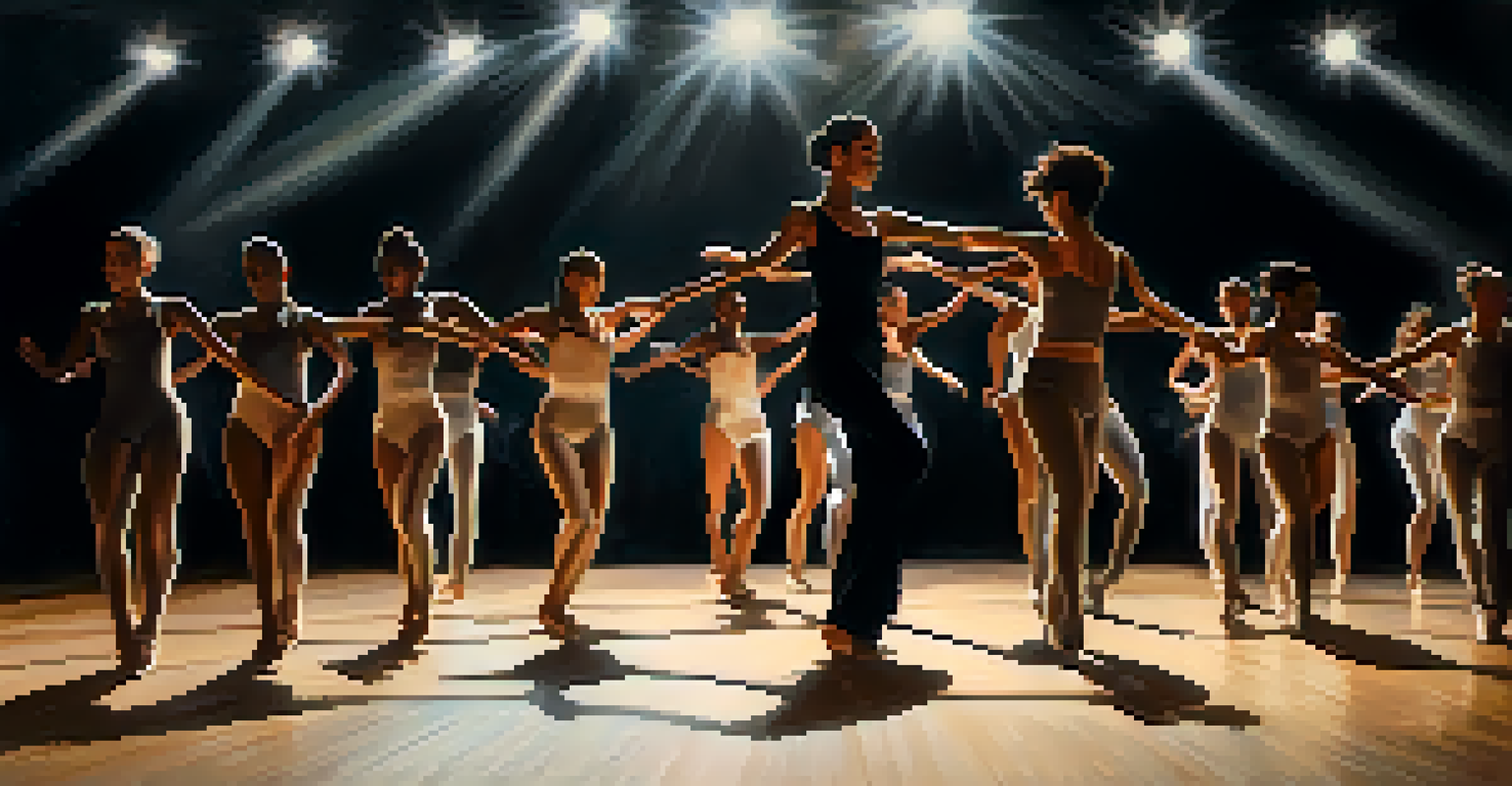The Impact of Historical Events on Choreographic Development

The Role of War in Shaping Dance Styles
Throughout history, wars have had a profound impact on the arts, including dance. For instance, the World Wars brought about a sense of urgency and emotion that influenced choreographers to express feelings of loss and resilience through movement. This era saw the emergence of new dance styles that reflected the chaos and heartbreak of the times.
Dance is the hidden language of the soul.
Moreover, military movements and formations often inspired choreographers to create works that echoed the discipline and strength of soldiers. This blending of military precision with artistic expression showcased the duality of war: destruction and beauty. As a result, dance became a powerful medium for commenting on the human experience during conflict.
In essence, the effects of war on dance extend beyond mere aesthetics; they offer a lens through which we can understand societal shifts and the emotional landscapes shaped by historical events. The evolution of dance styles often serves as a mirror, reflecting the tumultuous times in which they were created.
Cultural Movements and Their Choreographic Influence
Cultural movements, such as the Civil Rights Movement, have also left an indelible mark on dance. Choreographers began to use their art to convey messages of equality and justice, transforming performance into a form of activism. This period saw the birth of powerful works that not only entertained but also inspired social change.

Examples like Alvin Ailey’s 'Revelations' illustrate how dance can encapsulate the struggles and triumphs of a community. The fusion of traditional African dance with contemporary styles created a rich tapestry of movement that resonated with a broader audience. This blending of cultures in dance speaks to the resilience of the human spirit.
War Shapes Dance Styles
Historical conflicts have profoundly influenced dance, inspiring new styles that express themes of loss, resilience, and the duality of destruction and beauty.
Ultimately, the impact of cultural movements on choreography showcases the ability of dance to transcend mere entertainment and serve as a catalyst for dialogue and reflection. Dance becomes a narrative, telling stories of struggle and hope through its evolving forms.
Technological Advances and New Dance Forms
As technology advances, so too does the landscape of dance. The advent of video and digital media has allowed choreographers to explore new dimensions of movement and storytelling. This evolution has given rise to genres like dance film and multimedia performances, pushing the boundaries of traditional choreography.
The dance is a poem of which each movement is a word.
For instance, the integration of virtual reality into dance offers audiences immersive experiences that were previously unimaginable. Choreographers can now create environments where movement interacts dynamically with digital elements, enhancing the storytelling aspect of their work. This melding of technology and dance exemplifies how historical advancements can redefine artistic expression.
Moreover, technology has also made dance more accessible, enabling choreographers to share their works on global platforms. This accessibility fosters collaboration across cultures and styles, enriching the choreographic landscape and leading to innovative forms that reflect a diverse range of influences.
Social Change and Its Reflection in Dance
Social changes, such as the feminist movement, have significantly influenced choreographic development. Many choreographers began to challenge traditional gender roles and explore themes of empowerment through their work. This shift allowed for more diverse representations of identity and experience in dance.
For example, works by choreographers like Martha Graham emphasized the strength and complexity of female characters, moving away from the passive portrayals often seen in earlier dance forms. By using movement to express the struggles and triumphs of women, these choreographers created a new narrative that resonated with audiences worldwide.
Cultural Movements Inspire Choreography
Social movements like the Civil Rights Movement have transformed dance into a powerful medium for activism, showcasing struggles and triumphs through innovative choreography.
The reflection of social change in dance not only serves to entertain but also to educate and inspire. As choreographers respond to the evolving societal landscape, they create works that encourage dialogue around pressing issues, reinforcing dance's role as a powerful form of expression.
Colonialism and Its Impact on Dance Traditions
Colonialism has deeply affected dance traditions around the world, often resulting in a blend of indigenous and colonizer influences. This fusion has given rise to unique choreography that reflects the complexities of cultural exchange and resistance. Choreographers have utilized their art to reclaim and celebrate their heritage, often addressing the narratives surrounding colonization.
For instance, the incorporation of traditional African dance elements into contemporary forms highlights the resilience of these cultures in the face of oppression. The choreography often tells stories of survival and adaptation, serving as a testament to the enduring spirit of the communities involved. Through this lens, dance becomes a medium for acknowledging history while also embracing new possibilities.
Understanding the impact of colonialism on dance allows us to appreciate the diverse narratives that shape choreographic development. It underscores the importance of honoring and preserving cultural traditions while also exploring innovative expressions that arise from these historical contexts.
The Influence of Globalization on Dance Styles
Globalization has transformed the landscape of dance, facilitating the exchange of styles and techniques across borders. This interconnectedness has led to the emergence of hybrid forms that blend elements from various cultures, enriching the choreographic palette. Choreographers are now able to draw inspiration from a wider range of sources, creating diverse works that reflect a global perspective.
For example, the fusion of hip-hop with traditional Indian dance has led to the creation of vibrant performances that celebrate both cultures. This blending not only showcases the adaptability of dance but also highlights the importance of cultural dialogue in artistic expression. Such collaborations encourage audiences to appreciate the beauty of diversity in dance.
Globalization Blends Dance Traditions
The interconnectedness brought by globalization has led to the emergence of hybrid dance forms, enriching the choreographic landscape with diverse cultural influences.
As dance continues to evolve in our globalized world, it becomes increasingly important to recognize and respect the origins of various styles. This awareness fosters an appreciation for the histories and traditions that inform contemporary choreography, ensuring that the art form remains dynamic and inclusive.
Dance as a Reflection of Historical Narratives
Dance has always served as a narrative tool, conveying stories that reflect historical events and societal changes. Choreographers often use their work to comment on political, social, and cultural issues, creating a dialogue between the audience and the art. This connection allows dance to transcend mere performance, becoming a means of storytelling that resonates on a deeper level.
For instance, contemporary works that address themes such as climate change or social injustice illustrate how choreography can reflect pressing global issues. By weaving these themes into their movements, choreographers engage audiences in critical conversations about the world we live in. This ability to reflect historical narratives through dance reinforces its relevance in contemporary society.

Ultimately, the relationship between dance and historical narratives highlights the power of movement as a form of expression. As choreographers continue to respond to the world around them, they create works that not only entertain but also inspire reflection and change.